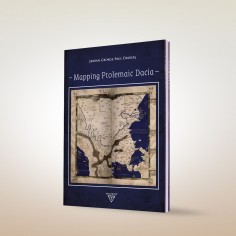




Publication date: February, 2020
Pages: 242, colour
ISBN 978-615-81353-6-8 Paperback, €28.00
ISBN 978-615-6405-17-3 Hardcover, €76.00
eISBN 978-615-81689-9-1 eBook, €28.00
DOI: 10.22618/TP.MPA
For any unavailable copies on our website, please refer to our distributors: ISD LLC for North and South America and EUROSPAN for Europe and the rest of the world.
 You can read part of this book in open access.
You can read part of this book in open access.
CHAPTER 1. General Ptolemaic Principles
CHAPTER 2. Ptolemaic and Modern Earth Models. Initial Methodological Framework
CHAPTER 3. Ptolemaic Poleis and Places in Dacia and in Adjacent areas. What We Know ![]() Download PDF
Download PDF
CHAPTER 4. Establishing Local Working Algorithms
CHAPTER 5. Calculating the Coordinates of Some Dacian Poleis from the Established Grid
CHAPTER 6. A Synthesis on the Local Ptolemaic Patterns in Dacia
CHAPTER 7. SWOT Analysis
CHAPTER 8. Limits, Rivers, Tribes and Neighbours of Ptolemaic Dacia
Conclusive remarks
Bibliography
List of Figures
List of Tables
Index
This volume is a contribution to the decipherment of Ptolemy’s universal map, with focus on the territory known as Dacia. The information provided by Ptolemy was translated into modern data considering local features and complying with certain general principles. The difficulty of this task consisted in the way the ancient manuscripts transmitted the original location coordinates, as well as in the way Ptolemy patched together information from ancient itineraries and other sources.
The author of this volume conceived a general formula for mapping Dacia based on the information found in the two oldest sources he used. Furthermore, he determined local patterns with the help of the other sources – therefore, defining locations resulted in a better determination of the surrounding relative positions. This information, as well as the correlation of the Ptolemaic locations with archaeological findings, provides an increased recognition of Ptolemaic Dacia, while also contributing to exposing the Ptolemaic universal map.
Şerban George Paul Drugaş holds a doctoral degree from the “Lucian Blaga” University of Sibiu (Romania), for a study on anthropology in religious and scientific thought. He has published several studies on theology and history, including a few on Dacian history. Şerban is a member of the Balkan History Association (BHA) and a collaborator of the Hiperboreea Journal, the biannual publication of the BHA.
I am most pleased to recommend Trivent publishing to anyone who is at the “publish a book” stage of life. The team is professional, outstanding, supportive, they are intelligent editors who will direct, not coddle, an author on his/her journey to publication.
I have been working with the Philosophical Journal of Conflict and Violence since its debut in 2017. It has been a pleasant experience to see how the papers take shape in the process from submission to peer review to publication. The editor-in-chief together with the Trivent team do a tremendous job and are always seeking quality above all!
I’ve participated in two conferences organized by Trivent in the last few years and both were a nice experience – went smoothly and had decent talks in good spirit. When it came to managing manuscripts, I was surprised by the professionalism by which they helped my text get published. I definitely enjoyed working with them!